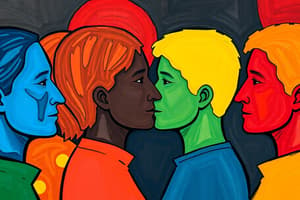Podcast
Questions and Answers
What does Social Identity Theory propose about individual identity?
What does Social Identity Theory propose about individual identity?
- People have multiple social identities that relate to group memberships. (correct)
- Identity is solely determined by personal achievements.
- Individuals have a singular personal identity.
- Social identities are fixed and unchanging.
Which of the following best describes social categorization?
Which of the following best describes social categorization?
- The process of uniting people under a common identity.
- Classifying individuals into groups based on similar characteristics. (correct)
- The act of emphasizing personal traits over social classifications.
- The psychological tendency to reject group memberships.
What was the main finding of Tajfel's Kandinsky versus Klee experiment?
What was the main finding of Tajfel's Kandinsky versus Klee experiment?
- Boys exhibited no preference between the groups.
- Boys displayed in-group favoritism by favoring their assigned group. (correct)
- Boys were more likely to award points to the out-group.
- Boys preferred to maximize joint profit over in-group profit.
According to Social Identity Theory, which mechanism is primarily responsible for enhancing self-esteem?
According to Social Identity Theory, which mechanism is primarily responsible for enhancing self-esteem?
What happens when one social identity becomes salient?
What happens when one social identity becomes salient?
Which criterion did NOT influence the boys' choices in point allocation?
Which criterion did NOT influence the boys' choices in point allocation?
What does the concept of in-groups and out-groups signify in Social Identity Theory?
What does the concept of in-groups and out-groups signify in Social Identity Theory?
During the experiment, the boys were given information solely based on:
During the experiment, the boys were given information solely based on:
Which statement accurately reflects how Social Identity Theory explains behavior?
Which statement accurately reflects how Social Identity Theory explains behavior?
What does in-group favoritism refer to in the context of Tajfel's research?
What does in-group favoritism refer to in the context of Tajfel's research?
Who proposed Social Identity Theory?
Who proposed Social Identity Theory?
How many boys participated in the Kandinsky versus Klee experiment?
How many boys participated in the Kandinsky versus Klee experiment?
Which of the following was NOT one of the systems used for awarding points in the experiment?
Which of the following was NOT one of the systems used for awarding points in the experiment?
What example illustrates the influence of social identity salience?
What example illustrates the influence of social identity salience?
What was the age range of the boys involved in Tajfel's study?
What was the age range of the boys involved in Tajfel's study?
Which option best exemplifies the concept of maximizing in-group profit?
Which option best exemplifies the concept of maximizing in-group profit?
Flashcards are hidden until you start studying
Study Notes
Social Identity Theory
- Social Identity Theory proposes that we have multiple social selves based on group memberships.
- We use group membership to understand who we are and find value within social contexts.
- Salient social identities influence our behavior.
- Our social identities can become more salient in certain situations.
Social Identity Theory Mechanisms
- Social categorization involves classifying people into groups based on shared characteristics.
- This categorization creates "in-groups" (us) and "out-groups" (them).
- Social comparison is the act of evaluating oneself by comparing one's group to other groups.
- Individuals tend to use group membership to enhance self-esteem.
Kandinsky vs. Klee Experiment
- 48 boys, ages 14-15, were randomly assigned to groups based on perceived art preferences (Kandinsky or Klee).
- Boys were given points to award to other boys, one from their own group and one from the other group.
- The experiment tested how different reward systems (maximum joint profit, maximum in-group profit, maximum difference) influenced the boys' choices.
- Results showed that in-group favoritism was prevalent and maximizing the difference in rewards to out-groups was preferred over maximizing joint profit.
Studying That Suits You
Use AI to generate personalized quizzes and flashcards to suit your learning preferences.




